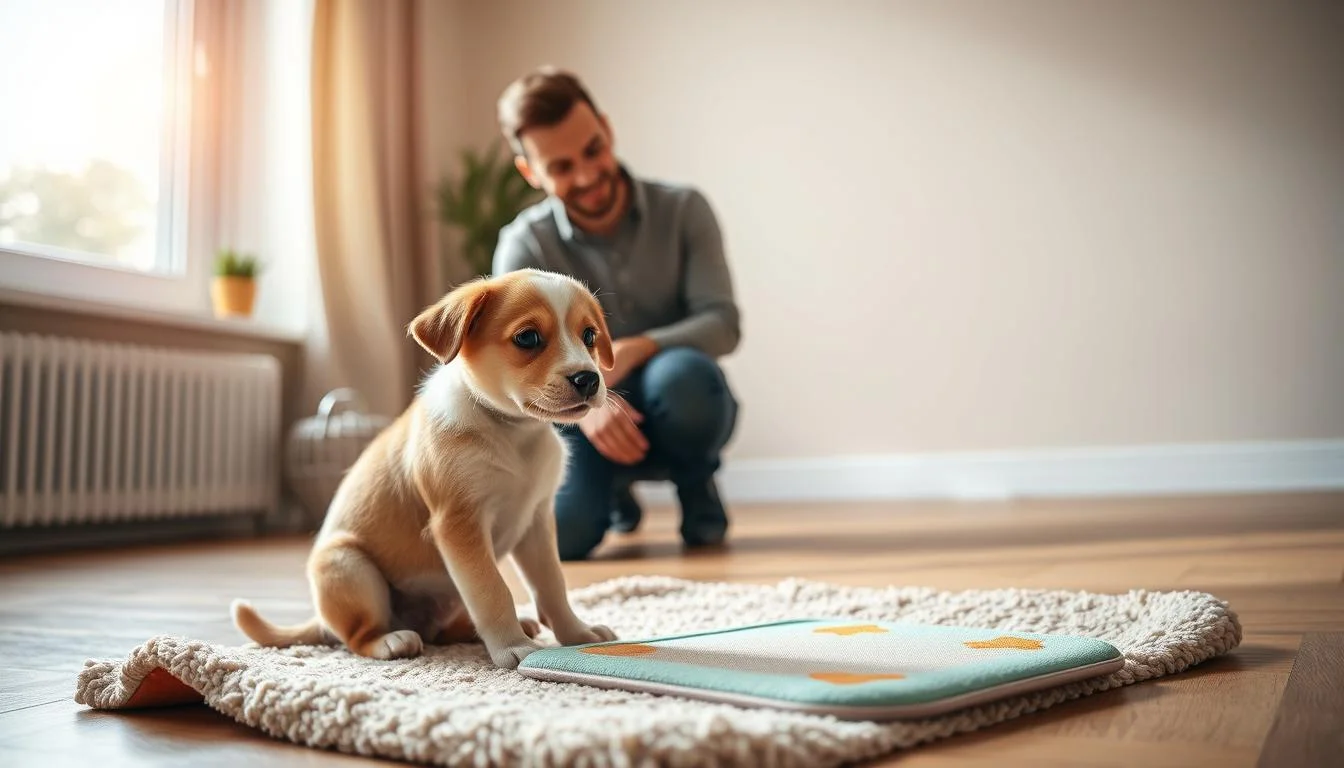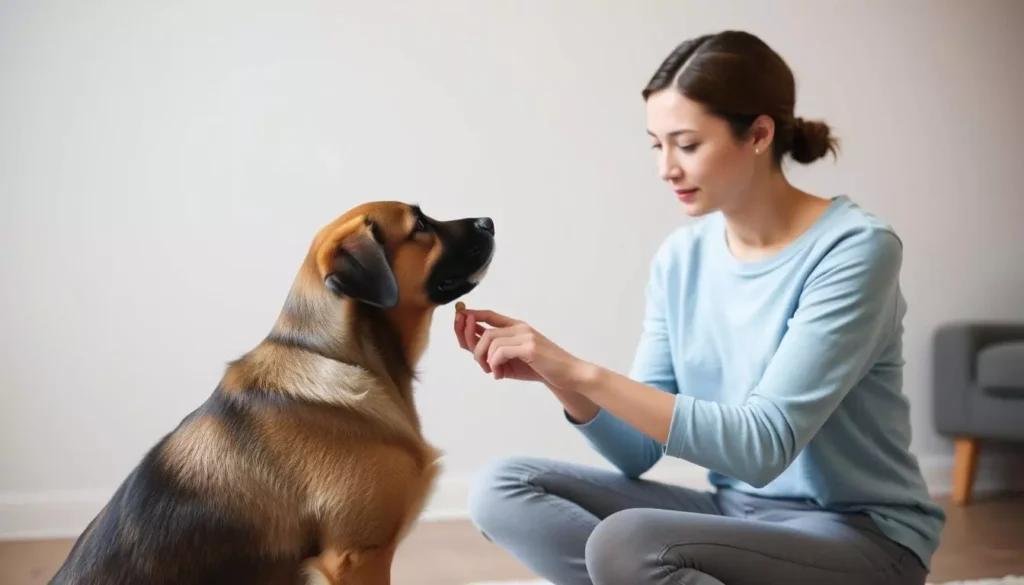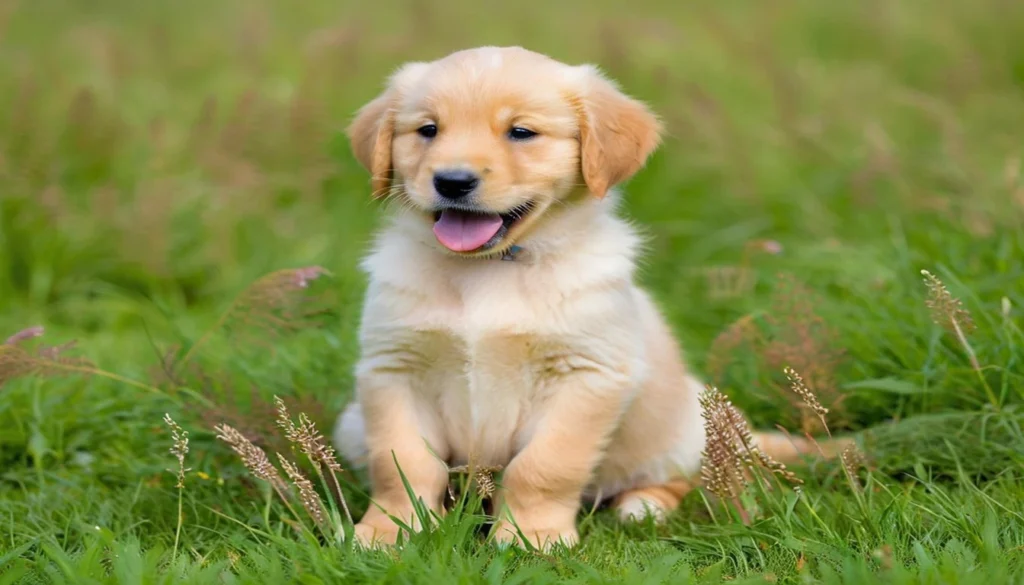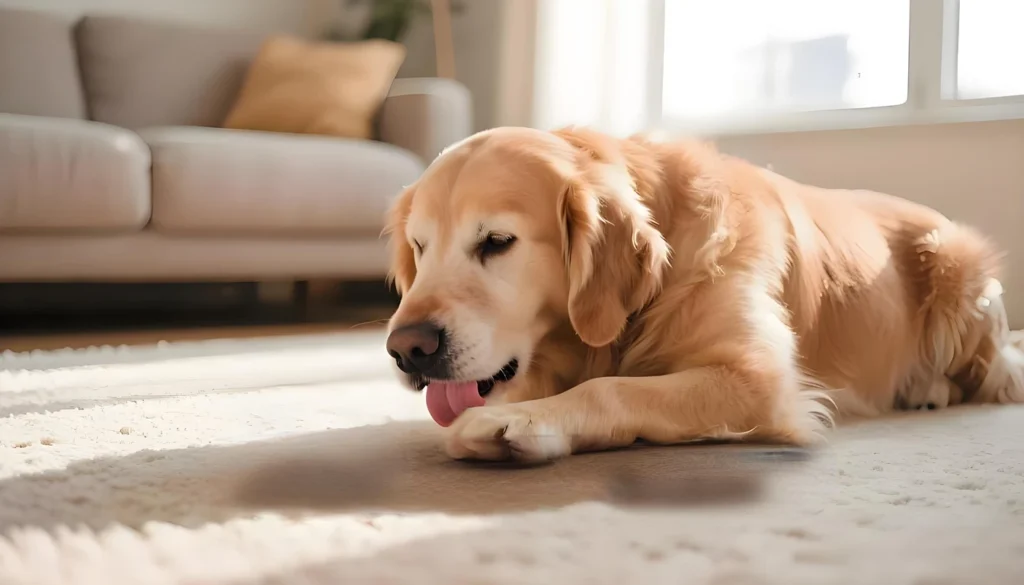I remember the first night with my Labrador mix. The soft whine, the nervous circling, and the cold patch on the floor were tough. Potty training was crucial for our bond.
I vowed to be patient, consistent, and kind. This promise changed everything.
Before getting a puppy, research and plan for housetraining. It gives your puppy structure and helps with obedience. It also keeps your home clean and smelling fresh.
For me, focusing on potty training, socialization, and simple commands made things easier. It made the whole process calmer and faster.
The best way to potty train a puppy is through repetition and positive reinforcement. I used a single cue, “go potty,” and a small treat after each success. Frequent trips outside, especially after sleep, play, and meals, helped build reliable habits.
Consistency is key. If you want to potty train a puppy fast, focus on a schedule, cues, and immediate rewards. Avoid punishment.
Key Takeaways
- Plan housetraining before bringing a puppy home to set clear expectations.
- Use a short, repeatable cue like “go potty” and reward immediately after success.
- Keep a consistent schedule with trips after waking, eating, and play.
- Positive reinforcement and repetition work better than punishment.
- Choose a regular outdoor spot and use a leash to create routine.
- Patience and persistence are essential for fast, lasting results.
Why potty training matters for a happy home
I've learned that potty training puppies is key to a happy home. A routine helps a puppy feel secure and reduces mess. Using the same techniques for house training makes learning faster and cuts down on accidents.
Long-term benefits for behavior and bonding
Starting early with potty training builds trust with your puppy. When you praise or reward them for going outside, it makes learning fun. This leads to fewer scoldings and calmer walks.
Household cleanliness and odor control
Keeping a clean house is easier with good potty training. I limit water before bed and watch playtime closely. Using enzymatic cleaners on accidents helps avoid smells and stains.
Setting expectations before you bring a puppy home
Before getting a puppy, I decide on a training method. I plan potty breaks around my work schedule and arrange for someone to walk them if I'm away. This makes the transition smoother and increases the chances of successful training.
| Focus | Why it matters | Practical tip |
|---|---|---|
| Routine | Creates predictability and fewer accidents | Set fixed meal and potty break times |
| Positive reinforcement | Strengthens bonding and encourages repeat behavior | Reward outdoor elimination immediately |
| Cleanliness | Prevents repeat soiling and household odors | Use enzymatic cleaner and limit late-night water |
| Pre-arrival plan | Reduces confusion on day one | Decide on crate, pads, or outdoor method ahead of time |
| Support | Keeps training consistent during busy days | Hire a dog walker or ask a neighbor for mid-day breaks |
Understanding puppy development and timing
Many new owners wonder how long to potty train a puppy. I explain that age and past experiences set realistic goals. Puppies under 8 weeks need almost constant help. By three to four months, they can hold urine longer.
A common rule is they can hold it roughly the number of hours that match their age in months. But, there's a lot of variation.
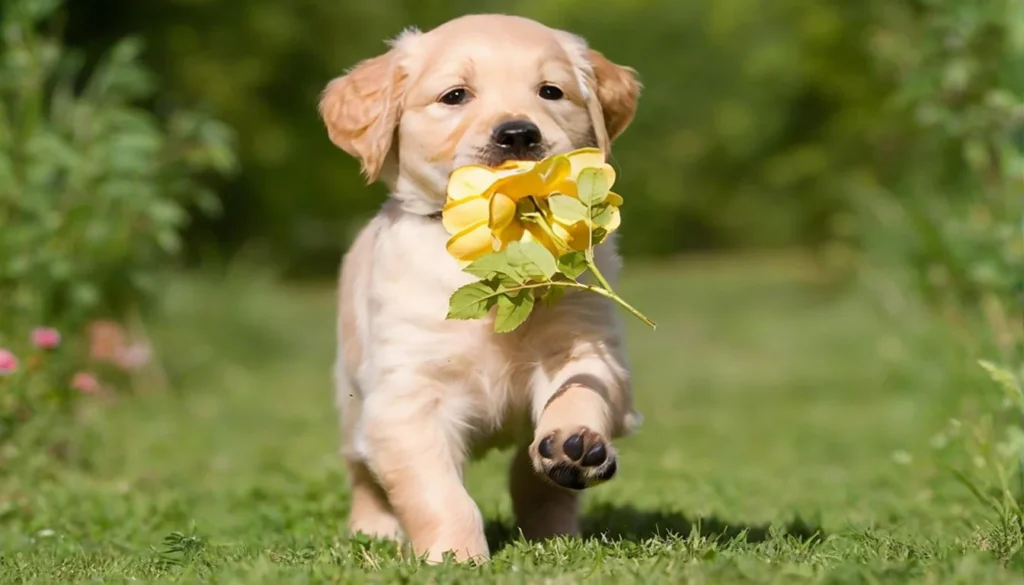
I tell owners that quick puppy potty training is a goal, not a promise. Some puppies from reputable breeders come with early routines. Rescued puppies often have past habits that affect housetraining.
If a rescue came from a shelter or was in kennels, expect extra time to rebuild trust and restart crate training.
Below I outline key developmental points and signs that help decide when to begin focused training.
Bladder control by age and realistic expectations
Puppies vary, but most follow a pattern. Newborns cannot control elimination. At two months, short stretches of dry time appear. At six months, many can manage several hours.
Small breeds may take longer to mature. I tell owners to plan for accidents and to avoid rushing the process.
How previous history affects learning
When a puppy comes from a breeder, basic routines are often in place. This makes transitions easier. Rescued pups sometimes learned to eliminate in confined spaces.
This training must be undone with patience and consistent cues. I recommend assessing their learning history and adjusting expectations rather than comparing them to other puppies.
Signs your puppy is ready to start focused training
Look for steady sleep, wake, and feeding cycles. Notice sniffing, circling, whining, or scratching at doors. If a pup responds to simple cues or eliminates outdoors with a reward, you can reduce constant supervision.
These signals mean you can move from basic care to more structured sessions.
I use effective puppy potty training methods that match each puppy’s pace. Short, frequent outings and consistent rewards work best. If you aim for quick puppy potty training, prioritize predictable routines and clear cues while staying patient with setbacks.
Creating a consistent potty training schedule
I create a simple routine for every day. A consistent schedule helps a puppy learn when and where to go. I use clear times for meals, potty breaks, and sleep to make it predictable.
I stick to a few key tips for potty training. I take the pup out in the morning and before bed. I also take them out after play, naps, meals, and when they chew toys or bones.
Short trips often help build bladder control and reduce accidents.
Meal times, potty breaks, and sleep routines
I feed my puppy three times a day for better predictability. Set meal times mean set potty times. I remove water 2.5 hours before bed to help with nighttime.
I keep naps and crate sleeps on a schedule. If the puppy wakes, I take them out right away. I praise them quickly when they go outside to encourage the habit.
How often to take a young puppy outside
For puppies under eight weeks, I take them out every one to two hours. Play or eating means a trip outside within minutes. I also plan extra trips after high-energy activities or treats.
If I have to work away, I find someone trustworthy to follow my schedule. Consistency from others keeps the puppy's training on track.
Adjusting the schedule as your puppy grows
I gradually increase the time between outings as the puppy gets better at holding it. Tiny puppies need to go often. By three to four months, I add more time between trips.
By six months, most dogs can hold it longer, depending on their breed and size. I watch for signs that the puppy is ready for longer intervals. Using small tricks, like a short leash to the same spot, helps speed up the learning process.
Crate training as an effective potty training tool
I use a crate as a key method for potty training my puppy. It taps into their natural den instincts. This makes it easier to prevent accidents when I'm not watching. I always make sure the crate is a safe space for naps and sleep, not a punishment.
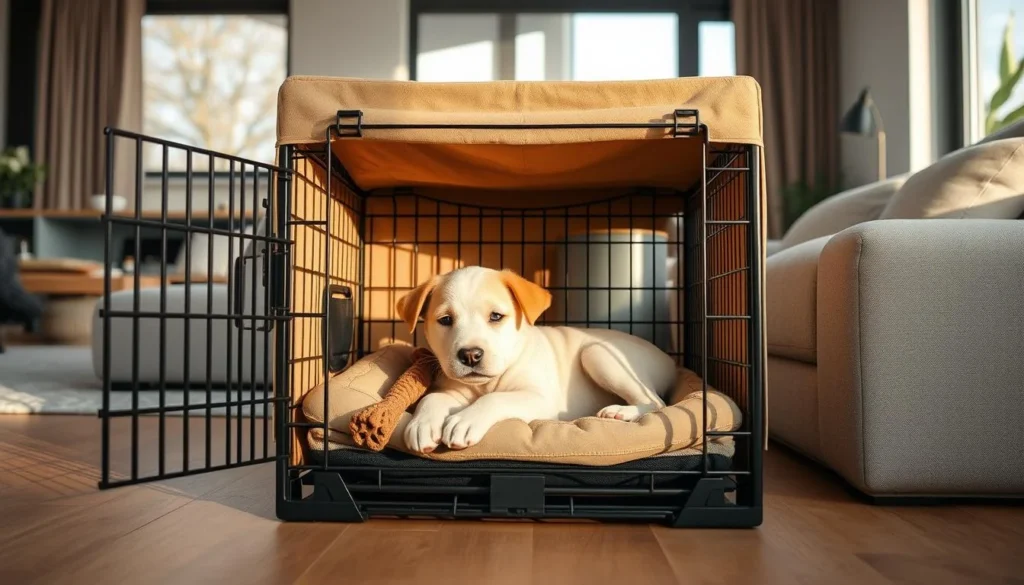
Here are some practical steps for crate training with potty training puppies. Each tip is short and easy to follow. You can start using them today and see progress quickly.
Why crates work: den instincts and cleanliness
Dogs don't like to soil where they sleep. A crate of the right size helps a puppy hold their bladder until you let them out. This makes crate training a great way to teach bladder control and create good habits.
Choosing the right crate size and using partitions
Choose a crate that lets your puppy stand, turn, and lie down comfortably. A crate that's too big can lead to accidents. I use a partition to make the space smaller as the puppy grows. This keeps the area small enough that the puppy won't use one corner as a bathroom.
How to introduce and reward crate use without fear
Introduce the crate slowly. Start by feeding meals inside, placing a soft bed, and giving small treats when the puppy enters calmly. Never force the puppy into the crate. If they whine, it means they need to go out. I respond quickly to avoid accidents and to teach the right behavior.
If the puppy soils the crate, I check my schedule and increase supervision. Shorter crate times and more outdoor trips help solve problems. Praise and tiny treats help the puppy associate calm crate time with good outcomes.
| Step | Action | Why it helps |
|---|---|---|
| Choose size | Crate fits stand, turn, lie | Prevents using far corner as toilet |
| Use partition | Shrink space as pup grows | Maintains appropriate den size |
| Make crate inviting | Bed, toys, meals inside | Builds positive association |
| Reward calm entry | Treats and soft praise | Encourages voluntary use |
| Respond to whining | Take outside promptly | Prevents accidents, reinforces schedule |
| Adjust routine | More breaks if crate soiled | Fixes timing, supports potty training puppies |
Using puppy pads and indoor potty options
I suggest using puppy pads when you can't take your puppy outside. This is true for tiny breeds in bad weather or for medical reasons. But, remember, pads can teach dogs to go in two places if not watched closely.
Choose puppy pads that soak up a lot and control odors. Brands like Pet Life Unlimited Smart Prints or Overnight pads are good. Place them near the door to help your puppy learn to go outside.
To move from pads to outside, start by placing pads closer to the door each day. As your puppy goes outside more, reduce pad use. Always praise them for going outside.
Keeping things clean is important. Change pads often and use cleaners on accidents. Use pads only when needed, like in playpens or crates.
Here are quick steps to use pads without slowing down outdoor training:
- Only use pads if you must; aim for outdoor elimination.
- Place pads near your chosen exit and use supervised sessions until the pup reliably uses the pad.
- Gradually shift the pad toward the door, then outside, while rewarding outdoor success.
- Swap pads frequently and clean accidents with an enzymatic product to remove odors.
- Keep a limited number of pads to avoid teaching multiple indoors spots.
If you need long-term indoor solutions for seniors or dogs with chronic conditions, pads are a good choice. My method balances convenience, cleanliness, and training. This makes the transition from pads to outside easy for both you and your puppy.
Positive reinforcement techniques that work
I use simple rewards to teach my puppy. Positive reinforcement makes learning faster when rewards come right after. Praise, a tiny treat, or a short play break makes learning fun for both of us.
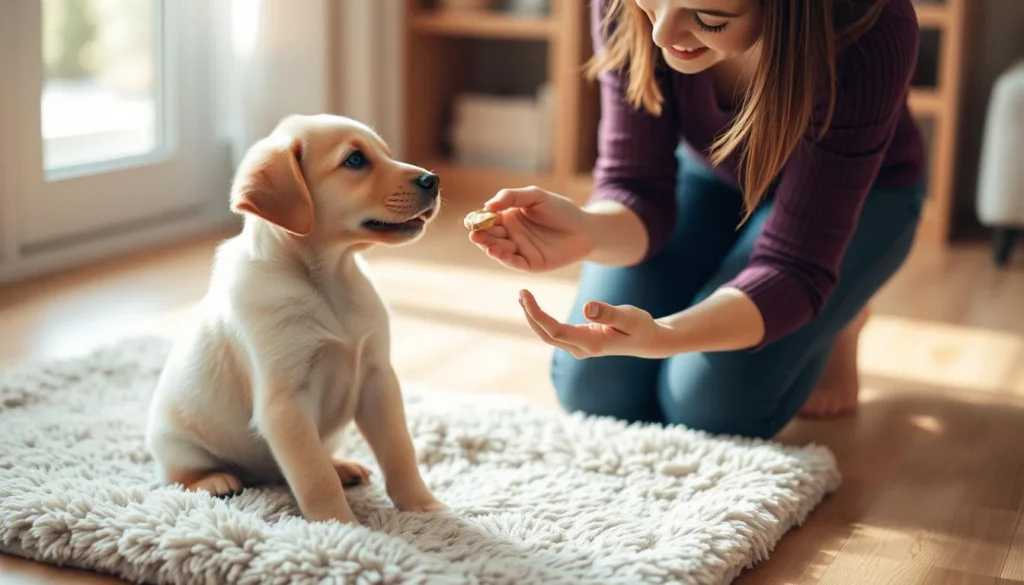
I watch closely to reward at the exact moment of elimination. Scolding after the fact confuses a puppy. If I catch the start of an accident, I gently interrupt, take the pup outside, and reward completion outdoors. This timing is key to fast potty training.
I use three main rewards to reinforce good habits. Small soft treats are best for quick training. I follow treats with praise and play to make going outside rewarding. These tips help the pup link the action with the payoff.
I keep treats tiny to avoid overfeeding. I save higher-value rewards for new locations or slower learners. After a successful break, brief play keeps the session positive and prevents punishment thoughts.
I pair the behavior with a short verbal cue and use it consistently. While the puppy is eliminating, I say, “go potty” in a calm voice. Once the pup finishes, I offer a reward. Repeating this cue helps the dog associate the phrase with the action and speeds recall when needed.
Below I compare reward choices and practical tips so you can pick a clear plan that fits your routine.
| Reward Type | When I Use It | How I Apply It |
|---|---|---|
| Tiny treats | Frequent training sessions and early mornings | I keep them bite-sized, reward immediately after elimination, and shift to praise as the pup gains consistency |
| Verbal praise | All successful outdoor eliminations | I use an upbeat tone and the cue phrase “go potty” while the puppy finishes, then reward with a treat or play |
| Play | After reliable outdoor eliminations or to motivate during training | I play for a few minutes outside to reinforce that going outdoors leads to fun, protecting progress when learning how to potty train a puppy fast |
| Combination | When teaching new locations or correcting regressions | I pair a treat, praise, and short play to strengthen the new habit; this approach aligns with puppy potty training tips from trainers |
Recognizing signals and supervising your puppy
I watch my puppy closely to catch early signs and prevent accidents. Learning to recognize puppy signals helps me act quickly. I keep routines that link meals, play, and naps to quick trips outside.
Common signs a puppy needs to go out
My pup circles, sniffs the floor, or gets restless when nature calls. Barking or scratching at the door and a quick squat are clear cues. When I see these signs, I take the puppy to the designated spot right away.
Leashing indoors and tethering for close supervision
I use a 6-foot leash indoors or tether my puppy to me or furniture. Treating the yard like a room and keeping the puppy leashed there helps. This way, I can supervise puppy behavior without missing small warning signs.
How to prevent accidents through proactive monitoring
Frequent trips after eating, drinking, playing, and waking cut down on mishaps. If I catch my puppy in the act, I pick them up and rush outside. When they finish outdoors, I reward them right away. When I must be away, I confine the pup to a small supervised area or use pads and arrange for a walker.
| Situation | What to watch for | Action I take |
|---|---|---|
| After meals | Sniffing, circling, restlessness | Take outside within 5–10 minutes and praise when finished |
| After play or training | Heavy panting, sudden quiet, sniffing floor | Short leash walk to potty spot and reward for success |
| First thing in morning / after naps | Waking, moving to door, whining | Immediate trip outdoors and consistent cue word |
| When unsupervised briefly | Puppy exploring, circling furniture | Use tether or small pen and provide pads if needed |
Controlling diet and feeding for predictable potty times
I stick to a simple, steady feeding routine to make potty breaks easier to predict. A consistent feeding schedule puppy owners use gives clear windows for elimination. Planning three small meals a day helps most young dogs finish and then go out soon after.
Feeding schedules and how they affect elimination
I keep meals at the same times each day so bathroom windows become reliable. Puppies tend to eliminate shortly after eating. Sticking to a regular pattern reduces surprise accidents and supports the best practices for puppy potty training that trainers like Zak George and vet clinics recommend.
Choosing quality puppy food and watching stool consistency
I select reputable brands such as Royal Canin or Hill’s Science Diet for balanced nutrition. Overfeeding or switching foods too often can lead to loose stools or bulky, smelly stool that complicates training. If stool quality changes, I consult my veterinarian and consider a gradual food transition.
Managing water before bedtime to reduce night accidents
I remove water about 2.5 hours before bedtime to cut down on overnight needs. Many puppies can sleep up to seven hours without a break when I control water access responsibly. If my puppy wakes me, I take them out calmly and return to bed quietly to avoid play and keep night routines predictable.
I monitor quantity, timing, and food type as part of controlling puppy diet and housetraining. Small, steady steps in feeding and hydration help me follow best practices for puppy potty training and build a schedule that works for both of us.
Troubleshooting common potty training problems
I help owners tackle common puppy housebreaking issues. Small accidents often show a need for more training. Repeated soiling might mean a behavior, schedule, or health problem.
Dealing with frequent accidents and persistent soiling
For frequent accidents, I focus on the basics. This includes strict feeding times, more outdoor trips, and constant watch. Puppies from kennels may need to learn new habits.
Interrupting a puppy early can prevent accidents. I never yell or punish. This keeps trust and speeds up learning.
When to consult a veterinarian for medical issues
Not all accidents are about behavior. If a puppy can't be housetrained, a vet visit is needed. They check for infections, parasites, or incontinence.
After a vet says it's not a health issue, I suggest a certified trainer. They create a plan based on the puppy's history and personality.
How to clean and remove odors to prevent repeat soiling
Enzymatic cleaners remove scent markers. I recommend using a product labeled for pet urine. Steam or bleach can mask smells, but enzymes remove the scent dogs detect.
For tough smells, repeat the cleaning and limit access. Place bedding or toys near the cleaned spot. This teaches the puppy it's not for elimination. Consistent cleaning helps quickly.
| Problem | Likely Cause | Immediate Action | Follow-up |
|---|---|---|---|
| Frequent daytime accidents | Inconsistent schedule or supervision | Increase outdoor trips; leash pup to you inside | Set strict feeding times; crate during unsupervised periods |
| Nighttime leaking | Immature bladder or excess water before bed | Limit water 2 hours before sleep; take out just before bed | Discuss bladder maturity with vet if it persists |
| Sudden accidents after training progress | Medical issue like UTI or stress | Collect a sample if possible and call your veterinarian | Obtain diagnosis; follow medical treatment and retrain |
| Repeat soiling in same spot | Scent not fully removed | Use enzymatic cleaner and block area | Retrain outdoors; restrict access until habit breaks |
| Persistent soiling despite efforts | Learned kennel elimination or behavior issue | Return to basics: schedule, crate, supervision | Consult a certified trainer or behaviorist after vet clearance |
I keep troubleshooting simple and step-by-step. For any owner unsure, I stress the importance of early action. This saves time and strengthens the bond.
How long it typically takes to potty train a puppy
I've seen a big difference in how long dogs learn to go potty outside. It depends on their age, past experiences, how consistent you are, and their personality. Some puppies learn fast, in just a few days. Others might take months of practice.
Factors that influence training speed
Age is a big factor. A younger puppy might not have as much control over their bladder. Puppies from shelters might have learned bad habits. The training methods and how consistent you are also play a big role.
Using a crate, setting regular meal times, watching them closely, and rewarding them positively can help. This approach can make learning faster.
Realistic timelines for different ages and breeds
Small breeds might take longer because they digest food quickly. Medium and large breeds usually get better bladder control by 4–6 months. Some dogs might not fully mature until 9–12 months.
With regular effort, most puppies can learn to go potty outside in a few months. This gives you a realistic timeline to work with.
Tips to speed progress without rushing the puppy
To make training faster, take them out right after meals, naps, and play. Use a single word and reward them right away. Keep a close eye on them and use a crate that's the right size at night.
Small victories help prevent accidents and build their confidence. Don't rush them; stress can slow them down.
Simple puppy potty training tricks for faster success
I share a few focused tips I use with clients to speed up puppy house training techniques while keeping things gentle. These tactics cut confusion for the puppy and give owners a clear plan for daily routines.
Using a consistent outdoor spot and leash routine
I pick one outdoor spot and take the pup there on leash every time. The leash keeps attention on the task and limits distractions. I say a short verbal cue while the puppy eliminates and reward immediately after completion to build the association.
Short training sessions and reinforcing small wins
I keep practice bursts brief and upbeat. Five minutes after a meal or wake-up is perfect. When the pup succeeds, I wait until the job is finished, then give a treat, praise, or a quick play break. Small wins add up fast with this method.
Designing a backup plan when you must be away
I arrange a dog walker or neighbor visits if I will be gone more than four hours. For longer gaps I use indoor options like pads or a sod box, knowing this can slow progress to full outdoor training. I keep enzymatic cleaner nearby and plan gradual transitions away from indoor aids when ready.
I combine these quick puppy potty training steps with consistent feeding and crate use for a well-rounded approach. Clear cues, short sessions, and reliable backup care help most puppies learn faster and keep homes cleaner.
Conclusion
Training a puppy to use the bathroom is easier than you think. It's all about simple habits like routines, clear signals, and rewards. Crate training, regular feeding times, and a set spot for going outside are key.
These steps make your puppy's life more predictable. They are the foundation of successful potty training.
Repeating commands and rewarding your puppy quickly helps them learn fast. Puppy pads or indoor spots are good for places without yards. But, make sure to teach them to go outside when you're ready.
Watching your puppy closely and controlling their food and water is crucial. If accidents keep happening, it's time to see a vet or a certified trainer. With patience and the right approach, your puppy will learn to go potty outside.

